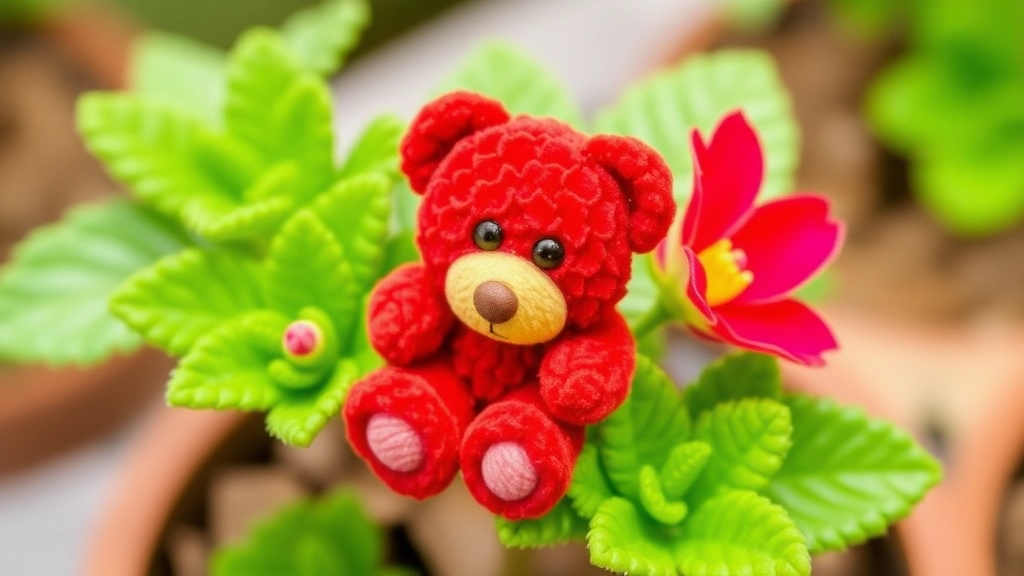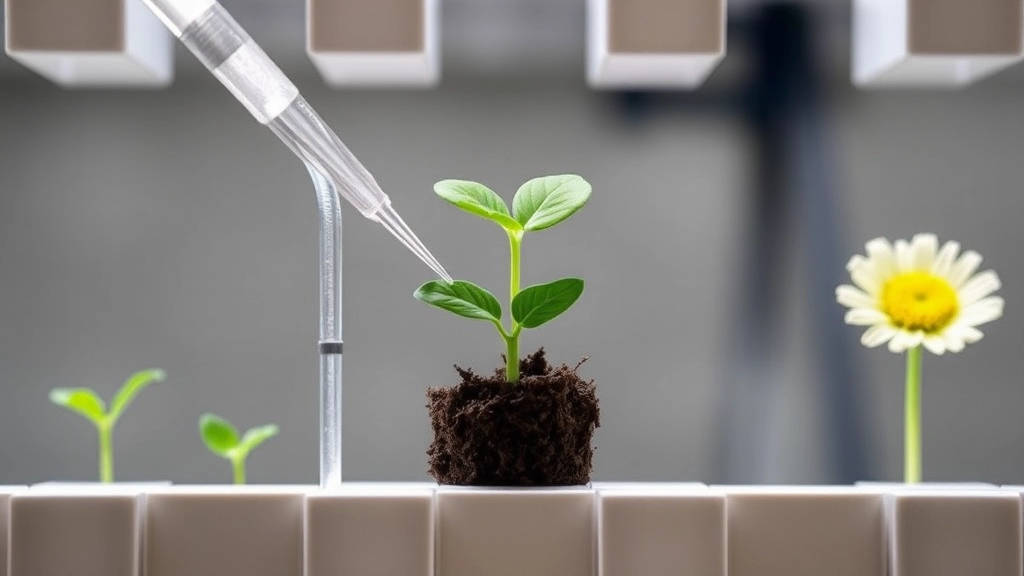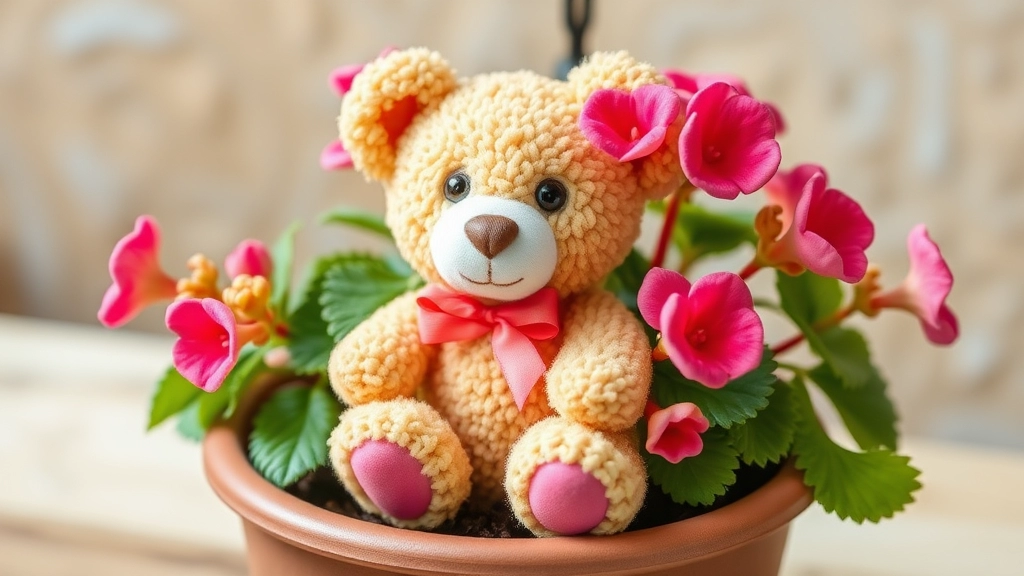Kalanchoe Teddy Bear
The Kalanchoe Teddy Bear, a variety of Kalanchoe tomentosa, is a delightful succulent known for its soft, fuzzy leaves and compact growth. This charming plant is perfect for adding a touch of greenery to your indoor space. Let’s dive into the unique features that make the Kalanchoe Teddy Bear a must-have for any succulent enthusiast.
Optimal Growing Conditions
To keep your Kalanchoe Teddy Bear thriving, it’s essential to understand its optimal growing conditions. This succulent prefers bright, indirect sunlight and well-draining soil. Watering should be done sparingly, allowing the soil to dry out completely between waterings. With proper care, your Kalanchoe Teddy Bear will flourish, adding a cozy, natural touch to your home decor.
Unique Features of Kalanchoe Teddy Bear
When considering unique houseplants, the Kalanchoe Teddy Bear stands out for several reasons.
This charming succulent is not just visually appealing; it brings a touch of whimsy to any space.
Key Characteristics
- Fuzzy Leaves: The Kalanchoe Teddy Bear features thick, rounded leaves adorned with soft, fuzzy edges. This texture not only adds to its charm but also makes it an excellent choice for tactile engagement.
- Vibrant Blooms: During its blooming season, this plant produces clusters of bright yellow or orange flowers, creating a stunning contrast against its green foliage.
- Compact Size: Typically growing to about 30 cm in height, its compact nature makes it suitable for small spaces, window sills, or even as a desk companion.
- Low Maintenance: Ideal for both beginners and seasoned plant enthusiasts, the Kalanchoe Teddy Bear requires minimal care, making it a hassle-free addition to your collection.
- Air Purifying Qualities: Like many succulents, it contributes to improving indoor air quality, making your living environment healthier.
These unique features not only make the Kalanchoe Teddy Bear a delightful presence in your home but also an easy-care option for those who may not have a green thumb. For more detailed instructions on how to care for this plant, check out our complete guide to Kalanchoe Panda Plant care. Additionally, if you’re interested in other fascinating varieties, the step-by-step guide to fuzzy Kalanchoe propagation might be of interest.
Optimal Growing Conditions for Kalanchoe Teddy Bear

So, you’ve got your Kalanchoe Teddy Bear, and you’re wondering, “What does it need to thrive?”
Let’s dive into the optimal growing conditions for this adorable succulent.
Light Requirements
First off, light is key.
Kalanchoe Teddy Bear loves bright, indirect sunlight.
- Ideal Spot: A south or east-facing window is perfect.
- Too Much Sun: Direct sunlight can scorch those fuzzy leaves.
- Too Little Sun: If it starts stretching, it’s craving more light.
Temperature and Humidity
Next up, temperature and humidity.
These little guys are pretty chill but prefer warmth.
- Ideal Temperature: Aim for 20-25°C (68-77°F) during the day.
- Nighttime: A slight drop is fine, but don’t let it dip below 10°C (50°F).
- Humidity: They thrive in low humidity, so no need for a humidifier!
Soil and Potting
Now, let’s talk about soil.
Kalanchoe Teddy Bear isn’t picky, but it does have preferences.
- Soil Type: Use a well-draining succulent or cactus mix.
- Pot Choice: A pot with drainage holes is a must to prevent root rot.
Air Circulation
Lastly, don’t forget about air circulation.
Good airflow helps keep your plant healthy.
- Placement: Avoid cramped spaces. A little space around your plant works wonders.
Watering and Fertilizing Needs
When it comes to caring for your Kalanchoe Teddy Bear, understanding its watering and fertilizing needs is crucial. Many plant enthusiasts often wonder, “How much water does my Kalanchoe really need?” or “Should I fertilize it?”
Watering Guidelines
Kalanchoe Teddy Bear thrives in well-draining soil, which means overwatering can lead to root rot. Here are some key points to consider:
- Frequency: Water your plant every 2-3 weeks, allowing the soil to dry out completely between waterings.
- Method: Use the soak-and-dry method. Water thoroughly until it drains from the bottom, then let it dry out.
- Signs of Overwatering: Yellowing leaves or mushy stems indicate too much water. Adjust your watering schedule accordingly.
Fertilizing Essentials
Fertilizing can help your Kalanchoe Teddy Bear flourish, but it’s important to do it right. Here’s what you should know:
- Type of Fertilizer: Use a balanced, water-soluble fertilizer diluted to half strength.
- Frequency: Fertilize every 4-6 weeks during the growing season (spring and summer).
- Avoid Over-Fertilization: Too much can harm your plant, leading to burnt leaf tips or stunted growth.
If you notice yellowing leaves, it might be a sign of overwatering. For more detailed information, check out our guide on why Kalanchoe bottom leaves turn yellow. Additionally, if you’re interested in propagating your Kalanchoe, our step-by-step guide on propagating Kalanchoe Flapjack can be very helpful.
IV. Propagation Methods

If you’re wondering how to expand your collection of Kalanchoe Teddy Bear plants, you’re in luck! Propagation is a straightforward process that allows you to create new plants from existing ones.
Leaf Cuttings
One of the most popular methods is using leaf cuttings. Here’s how you can do it:
- Select a Healthy Leaf: Choose a mature, healthy leaf from the parent plant.
- Cut the Leaf: Using clean, sharp scissors, cut the leaf at the base.
- Dry the Cutting: Allow the leaf to dry for a few days to form a callus, which helps prevent rot.
- Plant the Cutting: Place the callused end into well-draining soil, ensuring it’s about an inch deep.
- Water Sparingly: Mist the soil lightly and place the pot in a warm, bright location.
Offsets
Kalanchoe Teddy Bears often produce offsets, or small plantlets, that can be separated and planted. Here’s how:
- Identify Offsets: Look for small plants growing at the base of the parent.
- Gently Remove: Carefully separate the offset from the main plant.
- Replant: Plant the offset in its own pot with well-draining soil.
- Water: Keep the soil slightly moist until the new plant establishes roots.
Seeds
While less common, you can also propagate Kalanchoe Teddy Bear from seeds. Here’s a simple approach:
- Obtain Seeds: Purchase seeds from a reliable source.
- Prepare Seed Tray: Fill a seed tray with a light, well-draining soil mix.
- Sow Seeds: Sprinkle seeds on the surface and lightly cover them with soil.
- Moisture and Light: Keep the soil moist and place the tray in a warm, bright spot.
- Transplant: Once seedlings are large enough, transplant them into individual pots.
By employing these propagation methods, you can easily grow your collection of Kalanchoe Teddy Bear plants.
As we delve into the care of your Kalanchoe Teddy Bear, it’s essential to address a common concern: pests and diseases. Even the hardiest plants can face challenges, and knowing how to manage these issues will ensure your plant thrives.
Common Pests
– Mealybugs: These small, white insects often appear in clusters. They feed on the plant’s sap, leading to stunted growth.
– Aphids: Tiny and green, these pests can also sap the vitality from your Kalanchoe.
– Spider Mites: These are less visible but can cause significant damage, often leaving behind fine webbing.
Signs of Trouble
– Yellowing leaves
– Wilting or drooping
– Sticky residue on leaves (honeydew from pests)
Management Strategies
– Regular Inspection: Check your plant weekly for any signs of pests. Early detection is crucial.
– Neem Oil: A natural pesticide that is effective against many pests. Spray it on affected areas to deter infestations.
– Insecticidal Soap: This can be used to wash off pests without harming your plant.
– Isolation: If you notice a pest problem, isolate the affected plant to prevent spreading.
Disease Prevention
Kalanchoe Teddy Bear can be susceptible to diseases, particularly if overwatered.
– Root Rot: This occurs when the roots sit in water for too long. Ensure your pot has drainage holes and allow the soil to dry out between waterings.
– Fungal Infections: Look out for black spots on leaves. Remove affected leaves and improve air circulation around the plant.
For more detailed information on how to care for your Kalanchoe, you might find our [Ultimate Guide to Growing and Caring for Succulent Plant Kalanchoe](https://planthq.org/ultimate-guide-to-growing-and-caring-for-succulent-plant-kalanchoe/) helpful. Additionally, if you’re dealing with specific issues like leggy growth, check out our tips on [How to Fix a Leggy Kalanchoe](https://planthq.org/how-to-fix-a-leggy-kalanchoe-expert-tips-solutions/).
Display and Decor Ideas for Kalanchoe Teddy Bear
So, you’ve got your Kalanchoe Teddy Bear all set up, but how do you make it shine in your space?
Let’s dive into some fun and creative display ideas that’ll not only showcase your adorable plant but also elevate your home decor.
1. Choose the Right Pot
- Go for a quirky pot: Think about a ceramic pot with a fun design or a rustic terracotta one.
- Match colours: If your room has a theme, pick a pot that complements it.
2. Create a Plant Corner
- Cluster plants together: Group your Teddy Bear with other succulents or houseplants.
- Vary heights: Use plant stands or shelves to create visual interest.
3. Utilise Natural Light
- Window sills: Place your Kalanchoe where it can soak up that lovely sunlight.
- Hanging planters: If you’re short on space, consider hanging your Teddy Bear in a bright spot.
4. Incorporate into Your Decor
- Bookshelves: Nestle it between your favourite books for a pop of green.
- Desk buddy: Put it on your work desk to brighten up your workspace.
5. Seasonal Displays
- Festive touches: During holidays, add small decorations around your plant.
- Seasonal swaps: Change its spot with the seasons to keep things fresh.
6. DIY Projects
- Craft a terrarium: Create a mini ecosystem with your Kalanchoe and some pebbles.
- Upcycle containers: Use old cups or tins as unique plant pots.
These display ideas not only make your Kalanchoe Teddy Bear a focal point but also bring a touch of personality to your home. For more tips on caring for your Kalanchoe, check out our Kalanchoe Chocolate Soldier Plant Care Guide and our Step-by-Step Guide to Fuzzy Kalanchoe Propagation.
FAQs about Kalanchoe Teddy Bear
What kind of light does a Kalanchoe Teddy Bear need?
Kalanchoe Teddy Bear thrives in bright, indirect sunlight. A south or east-facing window is ideal. Too much direct sunlight can scorch its leaves, while too little light can cause it to stretch.
What is the ideal temperature for Kalanchoe Teddy Bear?
The optimal daytime temperature for Kalanchoe Teddy Bear is between 20-25°C (68-77°F). At night, it’s okay if the temperature drops slightly, but it should not go below 10°C (50°F).
Does Kalanchoe Teddy Bear need high humidity?
No, Kalanchoe Teddy Bear thrives in low humidity environments, so there is no need for a humidifier.
What type of soil is best for Kalanchoe Teddy Bear?
A well-draining succulent or cactus mix is ideal. It’s also important to use a pot with drainage holes to prevent root rot.
How important is air circulation for Kalanchoe Teddy Bear?
Good air circulation is crucial for the health of your Kalanchoe Teddy Bear. Avoid placing it in cramped spaces and ensure it has some space around it.
How can I propagate my Kalanchoe Teddy Bear?
You can propagate Kalanchoe Teddy Bear using leaf cuttings, offsets, or seeds. Each method has its own steps, but all are relatively straightforward.
What is the process for propagating through leaf cuttings?
To propagate through leaf cuttings, select a healthy leaf, cut it at the base, let it dry for a few days to form a callus, and then plant it in well-draining soil. Mist the soil lightly and place the pot in a warm, bright location.
How do I propagate using offsets?
Look for small plantlets growing at the base of the parent plant. Gently remove the offset and plant it in its own pot with well-draining soil. Keep the soil slightly moist until the new plant establishes roots.
Can Kalanchoe Teddy Bear be propagated from seeds?
Yes, although it is less common. Obtain seeds from a reliable source, fill a seed tray with a light, well-draining soil mix, sprinkle the seeds on the surface, and lightly cover them with soil. Keep the soil moist and place the tray in a warm, bright spot. Once the seedlings are large enough, transplant them into individual pots.
References
-
Growing Kalanchoe Plants: Information On Kalanchoe Plant Care
-
How to Grow and Care for Kalanchoe
-
Kalanchoe Plant Care Guide
